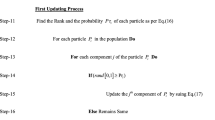Abstract
Image segmentation depend on fuzzy entropy (FE) and intelligent optimization is among the most widely used and popular approaches. Segmentation is an important and pre-processing step in the analysis of an image. Multilevel thresholding is efficient for color images in different multimedia applications in day-to-day life. The method of assessing optimal threshold values using conventional schemes consumes more time. To alleviate the above-mentioned problem, meta-heuristic method has been used for optimization in this area over the last few years. This paper proposes a novel image thresholding technique depend on Adaptive Flower Pollination Algorithm (AFPA) and type II fuzzy entropy (TII-FE). The thresholding methodology is assessed against competitive algorithms concerning the quality, convergence and accuracy of segmented images. The quality is computed in relation of SSIM, PSNR and MSE parameters. The results indicate that AFPA for TII-FE is effective technique for image thresholding.






Similar content being viewed by others
References
Abd Elaziz M, Sarkar U, Nag S, Hinojosa S, Oliva D (2020) Improving image thresholding by the type II fuzzy entropy and a hybrid optimization algorithm. Soft Comput 24:14885–14905
Agarwal P, Singh R, Kumar S, Bhattacharya M (2016) Social spider algorithm employed multi-level thresholding segmentation approach. Proc First Int Conf Inf Commun Technol Intell Syst 2:149–259
Agrawal S, Panda R, Bhuyan S, Panigrahi BK (2013) Tsallis entropy based optimal multilevel thresholding using cuckoo search algorithm. Swarm Evol Comput 11:16–30
Benzid R, Arar D, Bentoumi M (2008) A fast technique for gray level image thresholding and quantization based on the entropy maximization. In: 5th international multi-conference on systems, signals and devices. IEEE, Amman, pp 1–4
Bhandari AK, Singh VK, Kumar A, Singh GK (2014) Cuckoo search algorithm and wind driven optimization-based study of satellite image segmentation for multilevel thresholding using Kapur’s entropy. Expert Syst Appl 41:2538–2560
Chuang LY, Tsai SW, Yang CH (2011) Chaotic catfish particle swarm optimization for solving global numerical optimization problems. Appl Math Comput 217(16):6900–6916
Das S, Abraham A, Chakraborty UK, Konar A (2009) Differential evolution using a neighborhood-based mutation operator. IEEE Trans Evol Comput 13(3):526–553
He L, Huang S (2017) Modified firefly algorithm based multilevel thresholding for color image segmentation. Neurocomputing. 240:152–174
Horng M-H, Liou R-J (2011) Multilevel minimum cross entropy threshold selection based on the firefly algorithm. Expert Syst Appl 38:14805–14811
Jiang YC, Tang Y, Liu H, Chen ZZ (2013) Entropy on intuitionistic fuzzy sets and on interval-valued fuzzy sets. Inf Sci 240:95–114
Kansal I, Kasana SS (2020) Improved color attenuation prior based image de-fogging technique. Multimed Tools Appl 79:12069–12091. https://doi.org/10.1007/s11042-019-08240-6
Kapur JN, Sahoo PK, Wong AKC (1985) A new method for graylevel image thresholding using the entropy of the histogram. Comput Vis Graph Image Proc 29:273–285
Kukreja S, Kasana SS, Kasana G (2019) Histogram based multilevel reversible data hiding scheme using simple and absolute difference images. Multimed Tools Appl 78:6139–6162. https://doi.org/10.1007/s11042-018-6169-0
Kukreja S, Kasana G, Kasana SS (2020) Curvelet transform based robust copyright protection scheme for color images using extended visual cryptography. Multimed Tools Appl 79:26155–26179. https://doi.org/10.1007/s11042-020-09130-y
Kukreja S, Kasana G, Kasana SS (2021) Extended visual cryptography-based copyright protection scheme for multiple images and owners using LBP–SURF descriptors. The Visual Computer 37(6):1481–1498.
Li CH, Lee CK (1993) Minimum cross entropy thresholding. Pattern Recogn 26:617–625
Martin D, Fowlkes C, Tal D, Malik J (2001) “A database of human segmented natural images and its application to evaluating segmentation algorithms and measuring ecological statistics”. In Proceedings eighth IEEE international conference on computer vision, ICCV 2001, vol 2, pp 416–423.
Mlakar U, Potocnik B, Brest J (2016) A hybrid differential evolution for optimal multilevel image thresholding. Expert Syst Appl 65:221–232
Nag S (2017). A type–II fuzzy entropy based multi-level image thresholding using adaptive plant propagation algorithm. https://doi.org/10.31224/osf.io/5kqzd.
Otsu N (1979) A threshold selection method from gray-level histograms. IEEE trans Syst man Cybern 9:62–66. https://doi.org/10.1109/TSMC.1979.4310076
Pare S, Bhandar AK, Kumar A, Singh GK (2017) An optimal color image multilevel thresholding technique using grey-level co-occurrence matrix. Expert Syst Appl 87:335–362
Singh P, Mittal N (2021) An efficient localization approach to locate sensor nodes in 3D wireless sensor networks using adaptive flower pollination algorithm. Wireless Networks 27(3):1999–2014
Singh U, Salgotra R (2017) Pattern synthesis of linear antenna arrays using enhanced flower pollination algorithm. Int J Antennas Propag. pp. 1-11.
Sumathi R, Venkatesulu M, Arjunan SP (2018) Extracting tumor in MR brain and breast image with Kapur’s entropy based cuckoo search optimization and morphological reconstruction filters. Biocybern Biomed Eng 38(4):918–930
Wu X, Zhou Y, Lu Y (2017) Elite Opposition-Based Water Wave Optimization Algorithm for Global Optimization. Math Prob Eng. 2017 Article ID 3498363, 1, 25
Wu J, Wang YG, Burrage K, Tian YC, Lawson B, Ding Z (2020) An improved firefly algorithm for global continuous optimization problems. Expert Syst Appl 149:113340. https://doi.org/10.1016/j.eswa.2020.113340
Yang XS (2012) Flower pollination algorithm for global optimization. In international conference on unconventional computing and natural computation (pp. 240–249). Springer Berlin Heidelberg, Flower Pollination Algorithm for Global Optimization.
Author information
Authors and Affiliations
Corresponding author
Additional information
Publisher’s note
Springer Nature remains neutral with regard to jurisdictional claims in published maps and institutional affiliations.
Rights and permissions
Springer Nature or its licensor holds exclusive rights to this article under a publishing agreement with the author(s) or other rightsholder(s); author self-archiving of the accepted manuscript version of this article is solely governed by the terms of such publishing agreement and applicable law.
About this article
Cite this article
Mahajan, S., Mittal, N. & Pandit, A.K. Image segmentation approach based on adaptive flower pollination algorithm and type II fuzzy entropy. Multimed Tools Appl 82, 8537–8559 (2023). https://doi.org/10.1007/s11042-022-13551-2
Received:
Revised:
Accepted:
Published:
Issue Date:
DOI: https://doi.org/10.1007/s11042-022-13551-2




